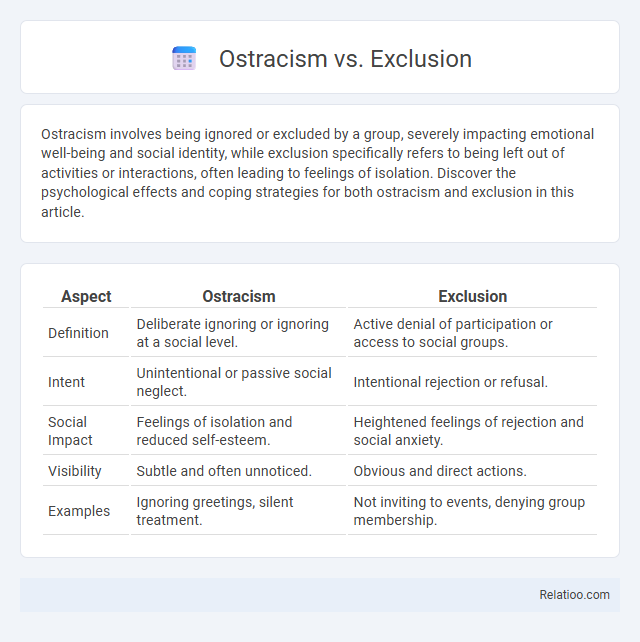Ostracism involves being ignored or excluded by a group, severely impacting emotional well-being and social identity, while exclusion specifically refers to being left out of activities or interactions, often leading to feelings of isolation. Discover the psychological effects and coping strategies for both ostracism and exclusion in this article.
Table of Comparison
| Aspect | Ostracism | Exclusion |
|---|---|---|
| Definition | Deliberate ignoring or ignoring at a social level. | Active denial of participation or access to social groups. |
| Intent | Unintentional or passive social neglect. | Intentional rejection or refusal. |
| Social Impact | Feelings of isolation and reduced self-esteem. | Heightened feelings of rejection and social anxiety. |
| Visibility | Subtle and often unnoticed. | Obvious and direct actions. |
| Examples | Ignoring greetings, silent treatment. | Not inviting to events, denying group membership. |
Introduction to Ostracism and Exclusion
Ostracism and exclusion both involve social rejection but differ in context and intensity. Ostracism refers to being ignored or excluded by a group, often without explicit explanation, impacting psychological well-being. Exclusion focuses on being deliberately left out from specific activities or social interactions, highlighting intentional social barriers.
Defining Ostracism: Key Characteristics
Ostracism involves deliberate ignoring or exclusion from social interactions, often leading to feelings of invisibility and social pain. It differs from exclusion, which is a more overt denial of access or participation, and rejection, characterized by explicit negative feedback or disapproval. Understanding ostracism's subtle yet impactful characteristics can help you better recognize and address its effects in social or workplace environments.
What is Exclusion? Core Concepts
Exclusion refers to the act of deliberately preventing someone from participating in a group or activity, leading to social isolation and feelings of rejection. Core concepts include intentionality, social rejection, and the resulting emotional and psychological impacts on the excluded individual. Your awareness of exclusion helps identify and address instances where social boundaries are unfairly enforced.
Psychological Impact of Ostracism
Ostracism triggers profound psychological impacts, often leading to feelings of loneliness, low self-esteem, and emotional pain due to social rejection. Unlike exclusion, which involves active rejection or denial of participation, ostracism typically manifests through silent treatment or ignoring, causing your brain to process this social pain similarly to physical pain. Understanding the unique psychological effects of ostracism can help you recognize and address the emotional distress it causes effectively.
Emotional Effects of Exclusion
Exclusion triggers significant emotional distress, often leading to feelings of loneliness, decreased self-esteem, and heightened anxiety. Unlike ostracism and social rejection, exclusion specifically disrupts individuals' sense of belonging by physically or socially removing them from groups or activities, intensifying emotional pain. Neural studies reveal that exclusion activates brain regions associated with physical pain, underlining its profound impact on emotional well-being.
Social Contexts: When Ostracism Occurs
Ostracism occurs in social contexts where individuals or groups intentionally ignore or exclude someone to enforce social norms or punish undesirable behavior. It often arises in workplaces, schools, and social groups as a means of control or social regulation. Unlike general exclusion, ostracism specifically involves a deliberate and sustained ignoring that impacts the target's sense of belonging and self-esteem.
Situations Leading to Exclusion
Situations leading to exclusion often involve social rejection due to perceived group norm violations, lack of shared interests, or differences in identity such as race, gender, or beliefs. In workplace or school settings, exclusion can result from power dynamics, competitive environments, or failure to conform to dominant social groups. Unlike ostracism, which includes ignoring or excluding someone without direct confrontation, exclusion specifically involves active decisions to leave individuals out of interactions or opportunities.
Comparing Ostracism and Exclusion
Ostracism involves ignoring or excluding someone by deliberate social snubbing, leading to feelings of invisibility and rejection, while exclusion refers more broadly to being left out from groups or activities, often resulting in social isolation and decreased participation. Both phenomena negatively impact psychological well-being, but ostracism emphasizes social invisibility, whereas exclusion highlights lack of access or acceptance. Research indicates ostracism triggers a unique neural response linked to social pain, distinguishing it from exclusion's focus on overt denial of membership or resources.
Coping Strategies and Resilience
Coping strategies for ostracism, exclusion, and ostracism involve building emotional resilience through mindfulness, social support, and self-affirmation techniques. Developing strong interpersonal connections and engaging in therapeutic practices can enhance your ability to recover from social rejection and maintain psychological well-being. Implementing proactive communication and stress management skills strengthens your resilience, helping you navigate the negative impacts of social exclusion effectively.
Preventing Ostracism and Exclusion in Communities
Preventing ostracism and exclusion in communities requires fostering inclusive environments that emphasize empathy, open communication, and equal participation. Implementing community programs that promote diversity awareness and conflict resolution can reduce social isolation and marginalization. Encouraging collaborative activities and creating safe spaces ensures members feel valued, reducing the psychological harm associated with ostracism and exclusion.

Infographic: Ostracism vs Exclusion
 relatioo.com
relatioo.com